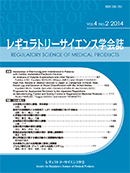Volume 7, Issue 2
Displaying 1-10 of 10 articles from this issue
- |<
- <
- 1
- >
- >|
-
2017Volume 7Issue 2 Pages 71-80
Published: 2017
Released on J-STAGE: May 31, 2017
Download PDF (390K)
-
2017Volume 7Issue 2 Pages 81-89
Published: 2017
Released on J-STAGE: May 31, 2017
Download PDF (706K) -
2017Volume 7Issue 2 Pages 91-97
Published: 2017
Released on J-STAGE: May 31, 2017
Download PDF (472K)
-
2017Volume 7Issue 2 Pages 99-103
Published: 2017
Released on J-STAGE: May 31, 2017
Download PDF (393K) -
2017Volume 7Issue 2 Pages 105-111
Published: 2017
Released on J-STAGE: May 31, 2017
Download PDF (730K) -
2017Volume 7Issue 2 Pages 113-120
Published: 2017
Released on J-STAGE: May 31, 2017
Download PDF (413K) -
2017Volume 7Issue 2 Pages 121-129
Published: 2017
Released on J-STAGE: May 31, 2017
Download PDF (1127K)
-
2017Volume 7Issue 2 Pages 131-141
Published: 2017
Released on J-STAGE: May 31, 2017
Download PDF (770K)
-
2017Volume 7Issue 2 Pages 143-144
Published: 2017
Released on J-STAGE: May 31, 2017
Download PDF (185K) -
2017Volume 7Issue 2 Pages 145-146
Published: 2017
Released on J-STAGE: May 31, 2017
Download PDF (164K)
- |<
- <
- 1
- >
- >|
